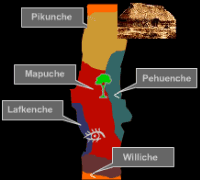
Welcome to the Mapuche Region. Here you will find interesting information about this Chilean Indigenous People.
The region contains four main subjects: People (History, Social Organization, environment), Language (Gramma, Vocabulary) and Customs (Spiritual World, Rituals, mythology) and Art. Use the interactive map to take an animated tour of this people´s region. The teachers and students will find contents (texts and images) to be able for Printing.
There is also a Resources section in which you will find a virtual Library with Dictionaries, Texts, Books and a complete Llinks Directory. In addition you could listen to music or watch documentaries in our Videos, Music and Storytelling sections. Finally if you have a question relating to something other than one of these topics, you can use our Search Engine or the Site Map or write to us through the Contact form. You are cordially invited invited to Subscribe our monthly Newsletter to be informed about the site and our Chilean Indigenous Cultures news.

The Mapuche Plattery is based in its religious beleifes. Each piece has a special meaning, that trascends with the ornamental and has a magical value, for example, the "Kaskavilla" was the magical instrument that was used by the Machi to keep away bad spirits and the "Silver belt" allowed the bonding with the gods. The material used was silver with melting techniques and laminated with cold or hot percussion.
Retrafe or silversmith was the name of the man that realized traditionally this duty.
Chilean coins were also used, being laminated by beats.
The name of the pieces that make the trousseau is: Trarilonko (hair lace), Lloven Nitrowe (women´s ornament), Chaway (earings), Traripel (neck fitting), Tupu y Katawe (clothe pin) Kilkai (hanging necklace) Sükill or Trapelakucha (chest pendant), Pentreor (chest hanging of three chains). Equestrian accesories like the Ispuela (spur), Istipu (stirrup) or all of the ironwork (rein, pitch and the break) called in mapudungun Witram plata, Kafishatu and Ketrel piriña.

The dual organization of the Mapuche Worldview influences also in the material demostration of silverware. It explore two diferent worlds: the woman one, support of the symbolic Mapuche speech, in which the Ad Mapu tradition hides, through the written worldview in the forms and contents drawn in the silverware; and the masculine one, personified herness of the horse that represent the sumission of shapes and Huinka contents to the dominant Mapuche descendents.
«In Argentina, the Mapuche people say, that Moon, after a great argument with the Sun, spilled its tears, that were so hot that they became silver. The Mapuche people then picked them and took care of them through all the wonderful and magical forms of silversmithing»
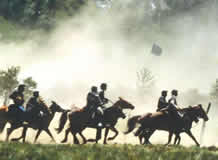
It is the verbal expression of their traditions, rituals and stories, the natural way of giving education, value and spiritual beliefs.
The Nütram in the Mapuche World, is the conversation that interwaines bits of myths, medicine recipes and stories from relatives and dead and alive neighbours.
We also stand out the existence of a literal form of an ethnic content that manifests subjects in relation to the original cultures. A paper that the spaniard chroniclers and other nationalities did in favour of the memory of the indigenous cultures and thanks to that today we can recognice extint cultures.
The actual Mapuche poetry is represented by a significant number of poets, constituting a recognized space and standing out in the National Literature names like Leonel Lienlaf, Elicura Chihuailaf and Jaime Huenún between others.

The Kultrun sums up the cosmic and earthly components, material and inmaterial, representing a synthesis of universe; a topographic limit that separates the natural earthly world from the supernatural world. It represents the symbolic structure of the Mapuche worldview, and such structure reflects the existence of contradictions and internal conflicts in the Mapuche beleifs.
When we decipher their simbols we find the codes to understand its profound and hermetic meaning.
With the resound of the drawn membrane, the meaning starts to vibrate: a chain series of simbolical relations, openinng a new temporary infinite dimension.
The Kultrun
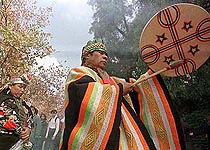 The Kultrun is the symbolic microcosmo of the Machi and the Mapuche Culture, in which it takes the shape of its particular spiritual conception of the universe.
The Kultrun is the symbolic microcosmo of the Machi and the Mapuche Culture, in which it takes the shape of its particular spiritual conception of the universe.
Its drawn membrane represents the cosmic superstructure and its diverse inmaterial components, representing like the four divisions of the square earth platform, oriented according to the four cardinal points, beginnig in the East, up to the land of the Four Places, or Meli Witran Mapu. On the other side, the wooden pot of the Kultrun, with the symbolic objects introduced in it, represent the cosmic and earthly infrastructure with its diverse material components.
According to the Mapuche belief, from this moment on the voice and the energy of the owner will remain forever inside the Kultrun, creating like an identification of the Machi with the instrument, that will symbolize her own voice and her own shamanic power.
Once completed the introduction of the Machi´s voice, the instrument is closed strongly, tying the edge.
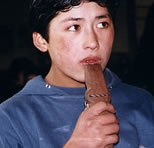
Pilfika:
Rustic whistle with a single orifice, without a determined tone and a real high sound. In the Mapuche culture it represents a bird named "Ñandu" calling her sons. Those are the whistles that are usually used by the Kuriche, during the Mapuche rogation.
Trutuka:
A large instrument that belongs to the family of aerophones. Galvanized pipe about 3 meters long with an old animal horn in one of its ends. The sounds comes when you exhale. It is played in the Patagonia and used in all types of ceremonies.
Its validity grade is very close to the chamanic practice of the Machi, being the one that practices the aborigin empiric-magical medicine and presides the different rituals of the Mapuche community.
Kaskawilla:
Bronze instrument, in the past it was based on pumpkins. In the rogation, the Kaskawilla is played by the Ñankan, the Machi assistant.
Piloilo:
This Mapuche musical instrument is used to cheer up parties. Its structure is of bone or stone. It is similar to the Pifilka, but it has more than one orifice.
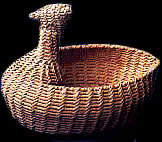
The humidity of the southern weather has disabled the conservation of these objects. However the trail of mapuche baskets can be followed through the stories left by the first spanish chronicles and afterwards by travelers.
Metawe They are of usefull character principally. This mapuche basket can be considered like the most representative between their baskets. It has strong and thick texture that make besides the characteristics of its rigid fiber a container of great resistence and capacity. It serves to contain, move and wash grains such wheat and corn.
LLepu or Balai is the name that this mapuche basket receives, that is used mainly to throw and clean cereals. It is knitted in different places in the same way but with different materials: with Ñoca in Arauco, with Quila in Cautín and with Boqui Pifulco in San Juan de la Costa. The technique used is with the aduja, that gives objects of great resistence and lasting.

Huilliches baskets
In San Juan de la Costa near Osorno, baskets knitted with Boqui is quite characteristic.
Two typesof baskets are elaborated. The one that uses "Quila" as raw material, it can be used to make baskets of various sizes destined for sale or domestic use: closets, baskets for washing clothes and wool. Baskets for wheat, to pick potatos or murtas. And the one that use "Boqui" as raw material, worked with the needle technique and the buttonhole stich: this production is of specialists and since the 80´s decade it is orientated to the matket. The "Boqui" is a variety of bindweed that grows in the mountains in the thickest part of the native forest, offering thickness and solidity to this handcraft.
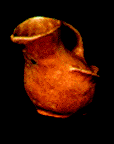
Nowadays, in the Mapuche territory a large variety of pottery is still manufactured. The most Known Metawes has simple line and natural colors . In the past, Ptirèn, represented the degree of development reached by this art before the arrival of the conquers .
The Mapuche pottery are slowly disappearing by lack of use. They distinguish various stylistic, but generally they are asymmetrical with shapes of ducks or frogs, some with eyes "coffe grain" tipe, cups like vasses and plates. But we have to stand out the pieces called "effigy dishes", with clays natural colour. Some represent human beings or objects such as "duck-dishes" or "frog-dishes", posibly linked to "ngenko", "the owner of the waters" . between the pottery objects that represent human beings, we stand out various pieces that represent a standing pregnant woman with her hands hugging or touching her womb, in clear allusion to the idea of fecundity.
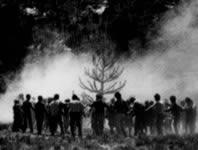
Dance is an activity practiced by man, that was born by the human necesity of expression. It is being spoken like spiritual motives characterized by fear, petitions or gratitudes to the divinity; of erotic or afective reason; of the warrior reason to scare the enemy and self excite himself to attack in battle, or the reason leagued to the crop celebration, etc.
All this explain why dancing involves a message, it is significant and has a spìritual content besides the esthetic one.

The nguillatún is a ceremony celebrated by several communities to assure good harvests, or to prevent disasters as earthquakes, bad weather, or volcanic eruptions.
It is also held to avoid and cure epidemics and sicknesses.
This ceremony consists of the sacrifice of a especially raised animal. A sacred fire is lit and a rewe, or sacred tree, is erected. The tree is the ritual center of singing and dancing.
Depending on the importance of what is being asked, the Nguillatun may be held for one or more days, having an animal sacrificed each day.
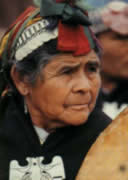
Pascual Coña, a Mapuche Cacique, describes the ceremony: "The principal Cacique kills two steer, four sheep, a horse and a pig (...) Each participant in the hosting community kills an animal (...) Then he yells: Oooo!, and sticks his fingers in the container of blood, spraying some while saying: 'Here you are father, blue sky, crusher of rivers (...) you have raised us; (...) give us abundance, all sorts of fruits of the land (...) Be propitious and have compassion, send us once more sun and rain, my lambs ask me, you will say of us, Oooo...!'"
Pascual Coña continues saying: "they agree on practicing on that day the preparatory rites and to plant the sacred tree (rewe) in the place destined to the celebration..."
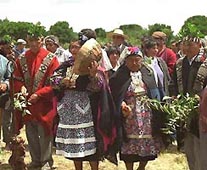
"Then they saddle their horses: the caciques, the young men, women and children; everyone heading towards the site of the celebration, and with them the machi, who plays the drum for a short dance. Once the rewe is erected, the nguenpín, who presides over the ritual, invites: 'Ya! Let us dance in honor of our rewe, let the flute play, The drum Machi!' (...) Now they start dancing around the rewe (...) While they dance, they ask for things, as they did before with the blood…".
The long detailed description concludes: "Again the Nguenpín orders: 'Let the guests come near, let the youths line up; hurry, hurry (...) That is it, get ready ladies, sons, hurry; the day is ending!' (...) They approach the rewe saying: 'Lets dance'...The dance moves around the rewe, two men carry, during the dance, a white flag and a black flag. Finally the nguenpín says to the guests: 'Well then, today our celebration took place, you all participated; the next celebration is your responsibility'."

The machitún is the healing ceremony. The machi, who nowadays is almost always a female, presides the ritual. In dreams, she receives the ancestral knowledge and the power to influence the nature of sicknesses and other natural phenomena.
The traveler E.R. Smith (middle of the XIXth century) describes the rite as follows: "When one resorts to a machi the visit takes place at dawn, because this is the most precise time for her managements... The patient must lie on his back in the middle of the ruka, all family members are asked to leave or, otherwise, they must facing the wall. After checking the symptoms, the machi begins a long magic ceremony consisting in a monotonous chant along with the playing of a small drum, made by a sheepskin stretched over a wooden frame. She becomes excited, making gestures and violent contortions, until falling on her back as in an epileptic fit, with her eyes turned up and foam coming out of her mouth and her body twisted in convulsions.
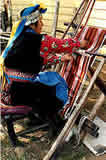
The Ad-mapu constitutes permanent wisdom. This knowledge is the group of symbols and traditional practices as well as the beliefs, which say that Chao created the Mapuches as well as the earth. The rituals recreate the Ad-mapu and also the reciprocity with Ngnechén, for the new gifts: life, health, and fertility.
Peuma or sleep is the contingent wisdom. Through it the Machi con see the rhythm of events and the meaning of dreams in everyday occurrences. The Perrimontún are the premonitions, through which the Machi receives warnings and announcements about future events.